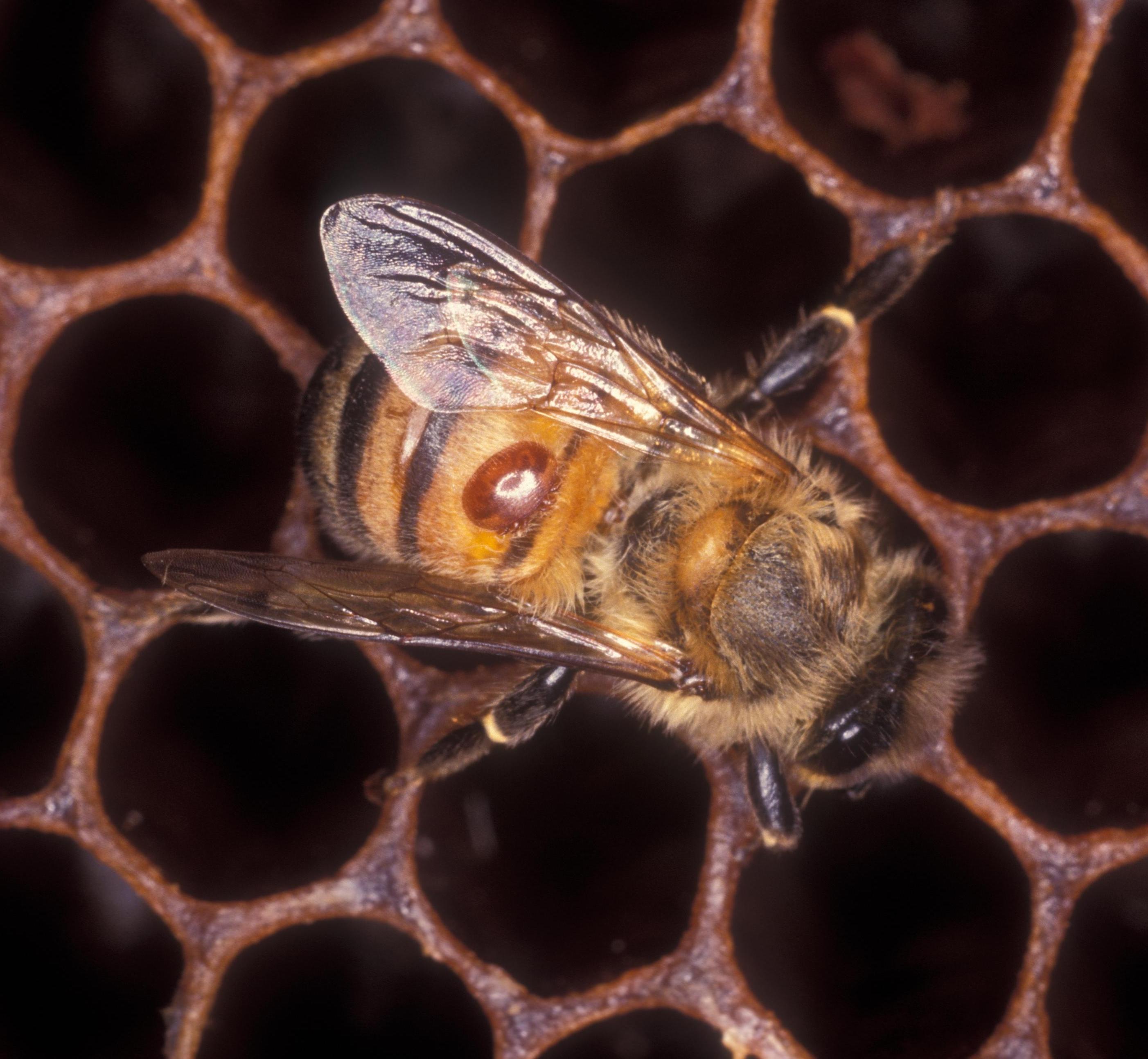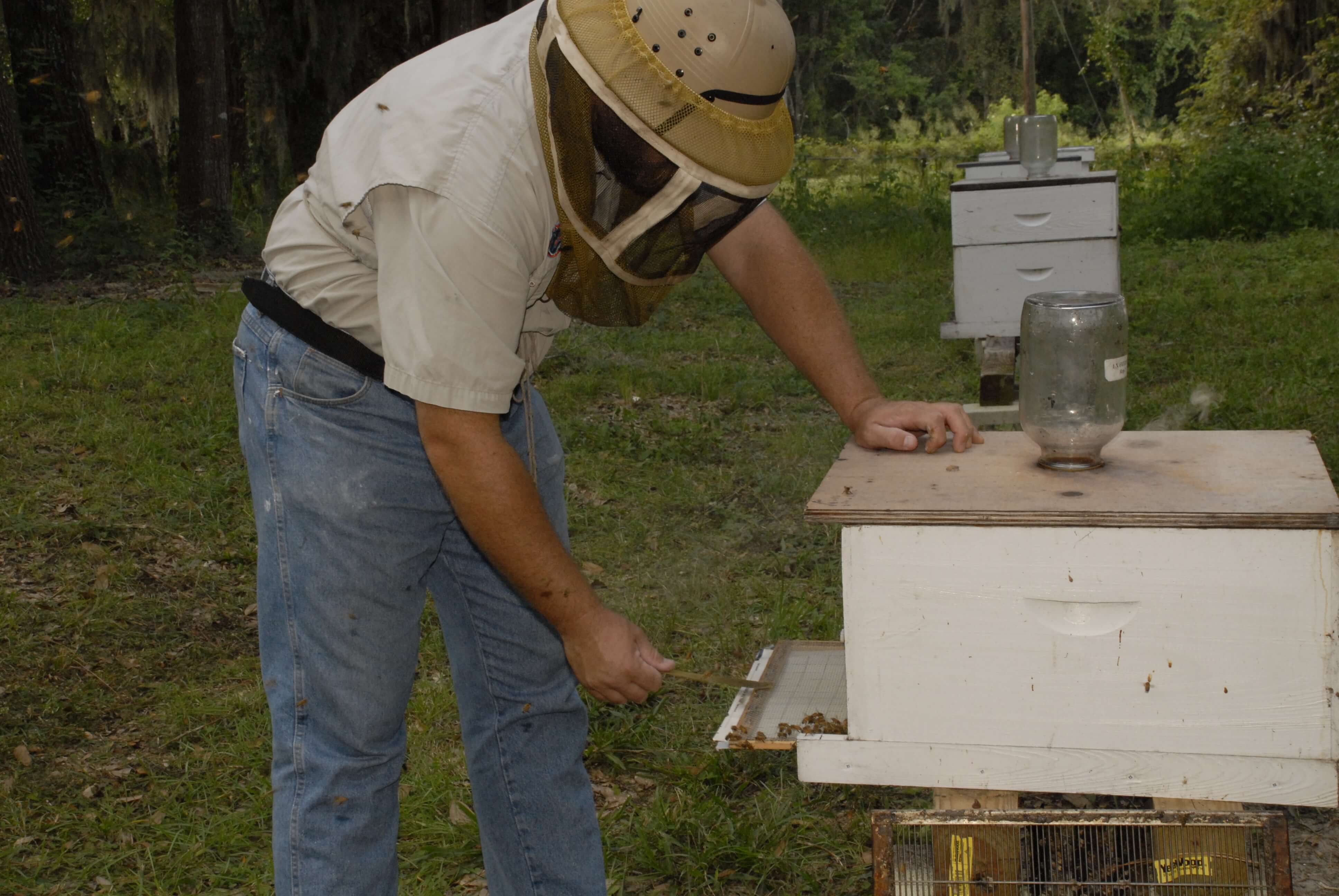
Varroa destructor is the Number One pest of our Western Honey Bee, Apis mellifera. This pest (commonly called Varroa or Varroa mite) is a parasite that feeds on a bee’s hemolymph, causing honey bee stress and eventually the death of developing and adult honey bees. A reduction in worker bee population affects a colony’s ability to feed and care for itself. Fewer adult honey bees also impacts the products and services important to the beekeeper including honey production, pollination services, and creating colonies for sale or replacement. The higher the Varroa population, the greater the damage to the honey bee population will be.
Biology and Reproduction
Varroa destructor is a mite and is not an insect. They are arachnids, relatives of ticks and spiders. A Varroa feeds on an adult or developing honey bee by piercing it and sucking the bee’s hemolymph. This weakens or kills the developing bee, reduces resistance to other diseases, and shortens the life span of adult bees. Furthermore, viruses can be transmitted to the individual honey bee during the mite’s feeding. These viruses then can cause other problems for the honey bee and its colony. This virus transmission would be similar to a tick feeding on a human and transmitting Lyme’s disease.

Varroa have two main stages in their life cycle: 1) reproductive stage and 2) wandering, phoretic stage. In the latter the mites attach to and move around with their host honey bees. Varroa destructor reproduces inside capped honey bee brood cells. The female mite, known as the foundress, enters a brood cell just before it is capped. Then after the honey bee brood cell is capped, she lays her offspring on the developing honey bee and she and her young feed on the prepupa/pupa. When the bee emerges, the foundress and her mature, mated female offspring exit the cell to search of another host. The mites, which can be seen on the adult honey bees, are now in the phoretic stage of the Varroa life cycle and are waiting to enter another brood cell to reproduce.
The mite population can grow exponentially and can double each month as long as honey bee brood is present. In worker bee brood cells the foundress and an average of one or two mature, mated daughters emerge, while the foundress and an average of two or three mature, mated daughters emerge from drone brood cells.
Management
Honey bees can tolerate a low population level of Varroa, but as the mite population rises, more honey bees are killed by the mites’ predation and by the viruses that they can vector.
Honey bees have several general defense mechanisms to combat Varroa including grooming behavior and hygienic behavior. Some genetic lines of honey bees will open/uncap brood cells in which Varroa are reproducing and pull out the developing honey bee. This specific type of hygienic behavior is termed Varroa Sensitive Hygiene (VSH). Varroa do not mature once the brood cell is opened. Thus, the immature mites die after the brood cell is opened. So far, these natural defense behaviors have not been enough to protect honey bee colonies from decline and death due to Varroa infestation. Beekeepers can help their bees control Varroa by employing other monitoring and treatment techniques.
You will likely never rid your colonies of Varroa, but how many mites are too many?
Monitoring
How can you determine the Varroa population in your colonies? There are several methods; some may tell you if Varroa are present while others can more accurately estimate your colony’s total Varroa load or level.
ARE VARROA PRESENT? (a starting place)
- General visual inspection of adult honey bees and brood frames: This is a start, however Varroa are small and difficult to see. If you see many bees with Varroa attached, you have a real problem. If you see many adult bees with deformed, crinkled, or twisted wings, you also probably have a heavy Varroa load. Varroa are a vector for Deformed Wing Virus (DWV). Honey bees who have DWV cannot fly so, cannot forage. Fewer foragers limits the colony’s ability to find and store food. Varroa can also vector other detrimental viruses which can kill your bees.
- Inspect capped drone brood cells: Beekeepers can look for Varroa feeding on drone prepupae/pupae within capped cells.
- Look for spotty brood pattern: If you see a spotty brood pattern during your inspection, something is wrong. If you see brood cells that have been opened by the bees and pupae are exposed, that is not normal. These may both be signs of a Varroa-ridden colony.
HOW MANY ARE THERE? (what you really need to know)
Even if you see Varroa on some bees or DWV or a scattered brood pattern, you still don’t know what the Varroa level is. If you don’t know how high the Varroa count is, you don’t know how serious the infestation is and if you need to treat your colonies. More effective sampling is necessary. Monitoring your colony for its Varroa load can be done by using a sticky board or by collecting 300 live adult bees.

- Mites per 100 bees
The current standard to quantify Varroa levels is to count the number of mites per 100 bees. To do this, 300 live adult bees (about a half of a cup) are collected from the brood area of a colony and then either powdered sugar, alcohol, or soapy water is used to dislodge any Varroa from the bees. Count the number of Varroa that you recover and divide that number by three. You then have the number of mites per 100 bees. Compare the number of Varroa per 100 bees found in your colony to a treatment threshold chart to determine if treatment for Varroa is needed. As a rule of thumb, when you see 3 or more mites per 100 bees, you should consider treating your colony for Varroa. See the Honey Bee Health Coalition, Tools for Varroa Management, a guide to effective Varroa Sampling and Control for details (including great videos) on sampling techniques, action threshold levels and legal Varroa treatments.
2. Sticky boards
Varroa fall off of bees naturally and when bees groom each other.A sticky board is placed under the hive will catch these mites that fall off of the bees. After three days, the sticky board is removed; the number of Varroa are counted and that number is divided by the number of days that the board was under the hive (e.g. if left for three days, divide the mite count by three). If the number of mites collected is over 40, the Varroa load is high enough to treat the colony. The sticky board sampling method assesses the mite drop from the entire colony but does not tally mites per 100 bees.

Treatment
Once you a have determined the level of Varroa infestation, then you may choose a method of control that fits with your beekeeping philosophy, the level of threat, and the season of the year. Integrated Pest Management (IPM) promotes a tiered strategy of control of the target pest while trying to limit harmful effects on the environment and other living organisms. Step-wise Varroa treatments consistent with IPM include cultural practices and chemical treatments. There are no vetted biological treatments for Varroa at this time.
Cultural practices:
Cultural practices take advantage of honey bee behaviors and/or Varroa biology. They aim to limit the number of mites that reproduce, thus slowing Varroa population build up.
- Queen selection: Choose new young queens, local survivor colony queens, or specialty queens (Russian, Varroa Sensitive Hygiene, Caucasian hybrid, Buckfast hybrid, Buckfast, improved Carniolan stock) to promote colony health.
- Screened bottom boards: When Varroa fall from the bees, they fall through the screen and out of the hive.
- Brood interruption or making splits: Interrupting the honey bee development cycle also interrupts Varroa development.
- Drone brood removal: Varroa prefer to reproduce in drone cells. By removing capped drone brood, you are also removing Varroa.
- Powdered sugar dusting:Being covered in powdered sugar causes bees to groove themselves and each other, likely dislodging mites at the same time.
Chemical controls

Essential oils and organic acids are sometimes called ‘soft’ chemical treatments. Both of these types of chemicals are considered organic treatments. Essential oils that are used in beekeeping are thymol, eucalyptol, menthol, camphor, and wintergreen oil and include the commercial products, Apiguard and Apilife Var. Formic acid, oxalic acid, lactic acid and hop beta acid are organic acid products. Remember, just because a product is “natural” or organic does not necessarily mean that it is safe for humans or bees. Always take great care to protect yourself by wearing the proper personal safety equipment as directed by the product label.
There are several synthetic products that are labeled for use in honey bee colonies that will kill Varroa. This list includes fluvalinate (Apistan), amitraz (Apivar) and coumaphos (CheckMite +). Synthetic products are sometimes called “hard’ chemicals.
Whether you choose a ‘soft’ chemical or synthetic chemical treatment, the concentration of the active ingredient in the treatment dose is higher than would naturally occur in a honey bee colony. You are adding to the variety of chemicals that the bees are exposed to in their own home. Treat when action thresholds are met, but before then start with some of the cultural practices discussed above. Remember, misuse of any type of product used to kill Varroa can cause damage to honey bee colonies and/or lead to the development of resistant strains of Varroa destructor. Always read and follow the label for any product that is used.
Additional Resources
Honey Bee Health Coalition, Tools for Varroa Management
EDIS Document: Varroa Mite, Varroa destructor Anderson and Trueman (Arachnida: Acari:Varroidae)
eXtension.org Article: Varroa Mites
Have something to say? Join the discussion on our Facebook Page
 0
0
